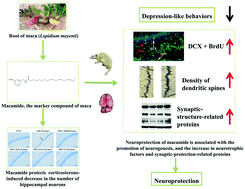Neuroprotective effects of macamide from maca (Lepidium meyenii Walp.) on corticosterone-induced hippocampal impairments through its anti-inflammatory, neurotrophic, and synaptic protection properties†
Abstract
The present study aims to investigate the protective effects of N-(3-methoxybenzyl)-(9Z,12Z,15Z)-octadecatrienamide (M 18:3) on corticosterone-induced neurotoxicity. A neurotoxic model was established by subcutaneous injection of corticosterone (40 mg per kg bw) for 21 days. Depressive behaviors (the percentage of sucrose consumption, the immobility time in the forced swimming test, and the total distance in the open field test) were observed. The levels of the brain-derived neurotrophic factor, the contents of tumor necrosis factor-α and interleukin-6, and the numbers of positive cells of doublecortin and bromodeoxyuridine in the hippocampus were measured. The density of hippocampal neurons was calculated. The morphological changes of hippocampal neurons (the density of dendritic spines, the dendritic length, and the area and volume of dendritic cell bodies) were observed. The expression levels of synaptophysin, synapsin I, and postsynaptic density protein 95 were measured. Behavioral experiments showed that M 18:3 (5 and 25 mg per kg bw) could remarkably improve the depressive behaviors. The enzyme-linked immunosorbent assay showed that M 18:3 could considerably reduce hippocampal neuroinflammation and increase hippocampal neurotrophy. Nissl staining showed that M 18:3 could remarkably improve the corticosterone-induced decrease in the hippocampal neuron density. Immunofluorescence analysis showed that M 18:3 could considerably promote hippocampal neurogenesis. Golgi staining showed that M 18:3 could remarkably improve the corticosterone-induced changes in the hippocampal dendritic structure. Western blotting showed that M 18:3 could considerably increase the expression levels of synaptic-structure-related proteins in the hippocampus. In conclusion, the protective effects of M 18:3 may be attributed to the anti-inflammatory, neurotrophic, and synaptic protection properties.



 Please wait while we load your content...
Please wait while we load your content...